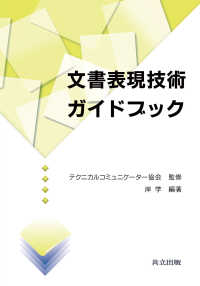- ホーム
- > 洋書
- > 英文書
- > Science / Mathematics
Full Description
Modern human societies rely on measurements. Measurements are essential for understanding and describing the world around us and the overall nature. Ensuring measurement accuracy, traceability, and consistency is important in scientific research, trade, manufacturing, health and medicine, and the everyday running of modern societies. One of the most essential components of measurement is the calibration. This book walks the reader through fundamental principles of calibrations, traditional calibration methods, the related standards, and procedures, as well as the fast‑developing and diverse range of artificial intelligence (AI)‑based calibration methods.
Calibration complies with strict regulations and legislation by governments, relevant authorities, and concerned parties. New and effective calibration techniques are evolving in parallel to the traditional methods. As explained here, new techniques that are based on AI offer instantaneous, continuous calibrations in standalone devices as well as in complex and large systems. Continuous and large‑scale calibrations are possible due to the new generation of computers and advanced digital systems, intelligent devices and sensors, communication networks, advanced mathematical methods, and the newly developed areas such as cyber‑physical concepts.
This book highlights that advanced technological and AI methods are applied for the calibration of distributed cyber‑physical and data‑driven applications. AI‑based calibrations find applications in large‑scale systems, where traditional methods have become almost impossible to implement or can be costly. Typical examples are Internet of Things (IoTs), self‑driving vehicles, intelligent transportation systems, unmanned aerial vehicles, drones and drone clusters, industrial processes, communication networks, health and medicine, environmental monitoring, pollution control, remote and inaccessible devices, smart cities, space explorations, management systems, economics, and finance.
Contents
1. General Concepts. 2. Calibration Strategies and Techniques. 3. Mathematical Methods in Calibration. 4. Calibration Steps. 5. Artificial Intelligence in Calibrations. 6. Applications of AI in Calibration. List of Abbreviations.








